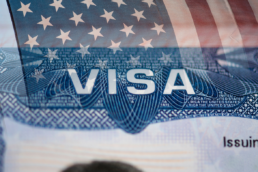Several associates from Berardi Immigration Law attended AILA’s sixth annual Canada/U.S. Border Immigration Fall Conference on Oct. 17. The conference focused on the intersection of U.S. and Canadian law and celebrated the 20th anniversary of NAFTA. In staying true to this focus, several CBP officers from the local Buffalo Peace Bridge served on a panel offering a Canada/U.S. border update.
U.S. Customs and Border Protection officers primarily enforce customs, immigration, and agricultural laws and regulations at U.S. ports of entry in order to protect our country from threats such as terrorists, weapon smugglers and drug traffickers. In terms of immigration matters, CBP officers also adjudicate foreign employment applications through the NAFTA treaty, such as TN and L-1 applications. At the recent AILA conference, the CBP officers gave some valuable information and statistics, as well as answered many complex questions.
During an average day, CBP officers at the Peace Bridge will process more than 15,000 passing vehicles and will speak to about 30,000 people. It comes as no surprise that the Peace Bridge is the second busiest border entry between the United States and Canada. In addition, the Peace Bridge is expected to gain 60 new CBP officers for the 2015 fiscal year. These officers will undergo thorough training, typically taking two to three months. The Peace Bridge may also be receiving expanded technologies in 2015.
While it has commonly been perceived that more and more people are being turned away at the border, CBP offered some statistics that seem to prove otherwise. In 2013, only .019 percent of all travelers were turned away at the Peace Bridge. In addition, only .006 percent of all travelers were turned away from entering the U.S. nationwide in 2013.
Another hot topic addressed at the conference was the changing eligibility of individuals due to new information sharing between CBP and other government agencies. CBP clarified how much information sharing actually goes on. CBP has a close working relationship with USCIS. In terms of information sharing, CBP is able to view approvals and denials recorded in the system, but does not always have access to individual case notes. CBP also has limited access to the Department of State and Consular records. However, there is a Department of State liaison available to CBP at all times. CBP also has regular meetings with Consular officers to help educate both sides.
At Berardi Immigration Law, our attorneys present applications at the Peace Bridge multiple times a week. Our attorneys prepare detailed applications for our clients and are well-versed in speaking with CBP officers. If you are interested in applying for a nonimmigrant business visa, please schedule a consultation with one of our knowledgeable attorneys today!
Related Posts
November 12, 2025
TN Success Story: Three-Year Approval for a Chemical Engineer
Ready to have Berardi on your side?
Whether you’re a business looking to hire or a professional hoping to relocate, immigration law can be complicated. But you don’t have to do it alone. Put our experience to work for you.


